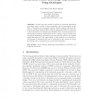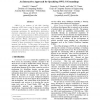DLOG
2003
14 years 4 months ago
2003
Description Logics (DLs), as a field of research, form a formal foundation of first-order semantic Web ontology languages, such as DAML+OIL and OWL. The Semantic Web will build ...
EPK
2006
14 years 4 months ago
2006
Abstract. Dieser Beitrag beschreibt eine Erweiterung der Ereignisgesteuerten Prozesskette (EPK), mit deren Hilfe die in nat
OWLED
2007
14 years 4 months ago
2007
Ontologies enable explicit expression of collective concepts and support Machine-to-Machine (M2M) interactions at the semantic level. Ontologies expressed in a standard language, s...
IICAI
2007
14 years 4 months ago
2007
In this paper we present a method to represent knowledge associated with a course. Course knowledge can be represented in the form of hierarchical prerequisite relation based weigh...
AMW
2010
14 years 4 months ago
2010
Abstract. We study the problem of instance level (ABox) updates for Knowledge Bases (KBs) represented in Description Logics of the DL-Lite family. DLLite is at the basis of OWL 2 Q...
ASWC
2006
Springer
14 years 6 months ago
2006
Springer
The Web Ontology Language (OWL), which is a Description Logic based ontology language, is widely used to represent formal definitions of vocabularies for domain knowledge, especial...
WIDM
2003
ACM
14 years 8 months ago
2003
ACM
Ontologies play an important role in the Semantic Web. Currently, several Web ontology languages have been proposed and there has been a substantial effort towards the formalizat...
WADT
2004
Springer
14 years 8 months ago
2004
Springer
Abstract. This paper describes a sublanguage of Casl, called CaslDL, that corresponds to the Web Ontology Language (OWL) being used for the semantic web. OWL can thus benefit from...
SKG
2005
IEEE
14 years 8 months ago
2005
IEEE
The upcoming next generation of the internet, often referred to as the Semantic Web, will bring a lot of new technologies, one of which is the Web Ontology Language (OWL). One fea...
EDOC
2005
IEEE
14 years 8 months ago
2005
IEEE
12 OWL-S is an instance of the Web Ontology Language (OWL) that is used to describe and specify semantic web services. While OWL-S provides a promising mechanism for specification...


